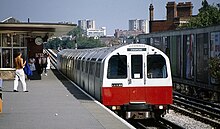London Underground 1983 Tube Stock
| London Underground 1983 Tube Stock | |
|---|---|
|
1983 Tube Stock at Depot Neasden (1988)
|
|
| Number: | 31½ moves |
| Manufacturer: | Metro Cammell |
| Year of construction (s): | 1983-1987 |
| Gauge : | 1435 mm ( standard gauge ) |
| Power system : | 630 V DC |
| Power transmission: | 2 power rails (positive and negative) |
| Seats: | 288 |
The London Underground 1983 Tube Stock (or just 83 Tube Stock for short) was a series of electric railcars that were used on the London Jubilee Line . According to the usual conventions of London Underground, the name is derived from the planned year of commissioning (1983).
history
The 1972 Mk.II Tube Stock , which has been used on the Jubilee Line since it opened in 1979, was only a temporary solution from the start and a fleet of around 60 trains of a new series was planned for the commissioning of construction sections 2 and 3 of the Jubilee Line to procure this line. It was planned that the existing trains of the 1972 Mk.II Tube Stock would be moved to the Bakerloo Line in order to replace the aging trains of the 1938 Tube Stock series . Since the construction of the other construction sections of the Jubilee Line was delayed further and further - and ultimately never built in the planned form - 15 trains of the 1983 Tube Stock type were ordered in May 1982 , as the 1938 Tube Stock trains on Bakerloo Line became increasingly unreliable and urgently needed to be replaced. The first cars of the 1983 Tube Stock were delivered at the end of 1983 and tested from the Neasden depot. The use in passenger traffic followed from May 2, 1984. Since when the new series was put into service, the old Bakerloo Line trains could already be replaced by other vehicles that were released due to timetable reductions, the 1972 Mk.II Tube Stock trains that became free different from the original plans moved to the Northern Line. As the number of passengers rose again, the decision was made in 1986 to order a second series of 16½ trains. The trains of the 2nd series only differed in minor details from the original trains and were put into service from November 27, 1987.
Additional vehicles were then required for the Jubilee Line Extension in the 1990s, but original considerations for a mixed use of old and new trains were quickly discarded because the new series would have had to be adapted to the trains of the 1983 Tube Stock , for example for the stations with platform screen doors a uniform door arrangement was necessary for all trains. A conversion of the trains of the 1983 Tube Stock was also not implemented, as the costs would have been too high. This resulted in the complete replacement of the trains with the new trains from the 1996 Tube Stock , which were used on the Jubilee Line from December 24, 1997 . The last use of the 1983 Tube Stock followed on July 9, 1998. Plans for a further use of the series were discarded because the vehicles appeared unsuitable, so the vehicles were parked, although some of the trains of the 2nd series were not even 10 years old Were on duty.
Many wagons were scrapped in Rotherham , others were parked in different places. One car is kept by the London Transport Museum , a few others are being used off the rail network as a studio for Radio Lollipop at Great Ormond Street Hospital or as artist studios on the disused Bond Street Viaduct in Shoreditch .
Train formation and details
A train of the 1983 Tube Stock consists of 2 half-trains each with 3 cars, so the result is a 6-car train. One car offered 48 seats. A half-train consisted of 2 motor vehicles with a driver's cab (Driving Motor Car) at the ends and a non-powered intermediate car (Trailer Car). During the development of the trains, many details were taken from the D78 floor , the chassis, brakes and the drive are similar, and the single-leaf doors were also adopted from the D78 floor . This feature, which is unique for vehicles on the London tube lines, turned out to be the greatest disadvantage of this series, as the narrower doors meant that passenger changes at the stations took longer than for vehicles with double-leaf doors. Compared to the D floor, the main problem was the equipment with only three instead of four doors, which was a hindrance for a quick passenger change.
commitment
The trains were used exclusively on London Underground's Jubilee Line , where the vehicles were replaced by the 1996 Tube Stock . A planned later use on the Piccadilly Line failed due to the shortcomings of the series, which appeared particularly problematic in mixed use with other series. The necessary widening of the doors would have been too costly. The 1983 tube-stock trains were used on the Jubilee Line until the summer of 1998; the last passenger service took place on July 9, 1998. The cars were then taken out of service because their design with the narrow doors meant that they could not be used on other lines.
Web links
- 1983 tube stock. SQUAREWHEELS.org.uk, June 28, 2006, accessed December 18, 2012 .
Individual evidence
- ^ Mike Horne: The Jubilee Line . Capital Transport Publishing, Harrow Weald 2000, ISBN 1-8541-4220-8
- ^ John Glover, Colin J. Marsden: London Transport Railways . Ian Allan, London 1984, ISBN 0-7110-1460-4


